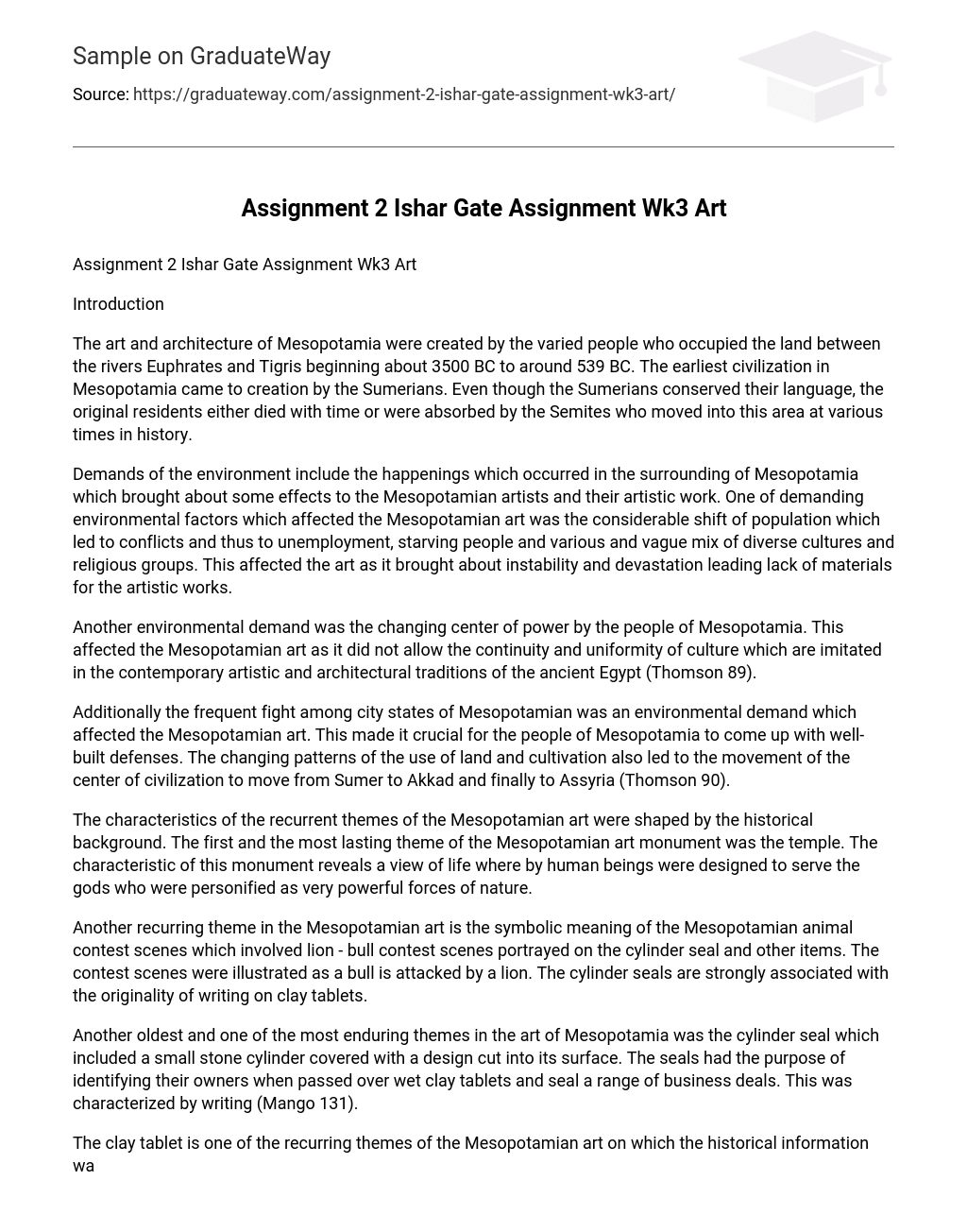Introduction
The art and architecture of Mesopotamia were created by the varied people who occupied the land between the rivers Euphrates and Tigris beginning about 3500 BC to around 539 BC. The earliest civilization in Mesopotamia came to creation by the Sumerians. Even though the Sumerians conserved their language, the original residents either died with time or were absorbed by the Semites who moved into this area at various times in history.
Demands of the environment include the happenings which occurred in the surrounding of Mesopotamia which brought about some effects to the Mesopotamian artists and their artistic work. One of demanding environmental factors which affected the Mesopotamian art was the considerable shift of population which led to conflicts and thus to unemployment, starving people and various and vague mix of diverse cultures and religious groups. This affected the art as it brought about instability and devastation leading lack of materials for the artistic works.
Another environmental demand was the changing center of power by the people of Mesopotamia. This affected the Mesopotamian art as it did not allow the continuity and uniformity of culture which are imitated in the contemporary artistic and architectural traditions of the ancient Egypt (Thomson 89).
Additionally the frequent fight among city states of Mesopotamian was an environmental demand which affected the Mesopotamian art. This made it crucial for the people of Mesopotamia to come up with well-built defenses. The changing patterns of the use of land and cultivation also led to the movement of the center of civilization to move from Sumer to Akkad and finally to Assyria (Thomson 90).
The characteristics of the recurrent themes of the Mesopotamian art were shaped by the historical background. The first and the most lasting theme of the Mesopotamian art monument was the temple. The characteristic of this monument reveals a view of life where by human beings were designed to serve the gods who were personified as very powerful forces of nature.
Another recurring theme in the Mesopotamian art is the symbolic meaning of the Mesopotamian animal contest scenes which involved lion – bull contest scenes portrayed on the cylinder seal and other items. The contest scenes were illustrated as a bull is attacked by a lion. The cylinder seals are strongly associated with the originality of writing on clay tablets.
Another oldest and one of the most enduring themes in the art of Mesopotamia was the cylinder seal which included a small stone cylinder covered with a design cut into its surface. The seals had the purpose of identifying their owners when passed over wet clay tablets and seal a range of business deals. This was characterized by writing (Mango 131).
The clay tablet is one of the recurring themes of the Mesopotamian art on which the historical information was written and on which the business deals were recorded by merchants. For instance the Sumerian lamented on the clay tablets of the Mesopotamian art creating memories of the destruction of the great old city of Ur in Mesopotamia. The clay tablets mention the countries and towns of Elam, although they do not give the geographical location.
Finally a recurring theme in the art of Mesopotamia involved the use of animal heads and human bodies on making vessels and other objects especially in minor arts. Other persistent themes include the art of creation which range from god creating the earth from chaos to a specific animal creating it from a handful of mud (Collon 28). Another common idea is the golden age where the humankind is thought of as having come from a previous perfection.
Conclusion
The Mesopotamian art remains to be exclusive events in the history of arts and architecture. Despite the demanding environmental factors which mostly affected the art negatively, the Mesopotamian art still remained outstanding and managed to maintain some its recurring themes.
Works cited
Thomson, Robins. Mythologies in Mesopotamia in South Kramer. 2nd ed. New York: Diane
Publishing Co, 1961.
Mango, Maurice. The Tradition in the Art of Mesopotamia. Washington DC: Dumbarton Oaks,
1982.
Collon, Denis. Ancient Eastern Mesopotamian skills. London: The British Museum Press, 1995.





